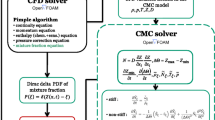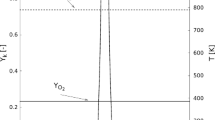Abstract
This paper presents a sensible-enthalpy-based conditional moment closure (CMC) model for homogeneous charge compression ignition (HCCI) with temperature inhomogeneity. The focus of study is placed on the effects of a conditioning variable on the prediction of heat release rates and developing the mixing models for sensible enthalpy, a reacting scalar. The sensible-enthalpy-based CMC model is validated a priori with 2-D direct numerical simulation (DNS) data for HCCI, and compared with the total-enthalpy-based formulation. Sensible enthalpy is shown to be strongly correlated with temperature, which makes sensible enthalpy well suited for a conditioning variable in CMC for HCCI. Results show that sensible-enthalpy-based CMC performs well for the prediction of heat release rates for all temperature stratification levels investigated in this study, while total-enthalpy-based CMC leads to the overprediction of heat release rates when the temperature stratification level is high. While conditional fluctuations of species mass fractions are substantial, sensible-enthalpy-based CMC is found to accurately estimate heat release rates during ignition, as well as reaction rates of key species, due to substantially suppressed conditional temperature fluctuations. The mapping closure models for the probability density function (PDF) and conditional dissipation rates of sensible enthalpy are proposed. The proposed models are found to capture the characteristics of reactive scalar mixing.















Similar content being viewed by others
References
Yao, M., Zheng, Z., Liu, H.: Progress and recent trends in homogeneous charge compression ignition (HCCI) engines. Prog. Energy Combust Sci. 35(5), 398–437 (2009)
Zhao, F., Asmus, T.W., Assanis, D.N., Dec, J.E., Eng, J.A., Najt, P.M.: Homogeneous charge compression ignition (HCCI) engines: Key research and development issues progress in technology PT-94 (2003)
Saxena, S., Bedoya, I.D.: Fundamental phenomena affecting low temperature combustion and HCCI engines, high load limits and strategies for extending these limits. Prog. Energy Combust. Sci. 39(5), 457–488 (2013)
Anders, H., Christensen, M., Johansson, B., Franke, A., Richter, M., Aldén, M.: A study of the homogeneous charge compression ignition combustion process by chemiluminescence imaging. SAE Technical Paper 1999-01-3680 (1999)
Peng, Z., Zhao, H., Ma, T., Ladommatos, N.: Characteristics of homogeneous charge compression ignition (HCCI) combustion and emissions of n-heptane. Combust. Sci. Tech. 177(11), 2113–2150 (2005)
Hultqvist, A., Christensen, M., Johansson, B., Richter, M., Nygren, J., Hult, J., Aldén, M.: The HCCI combustion process in a single cycle-speed fuel tracer LIF and chemiluminescence imaging. SAE Technical Paper 2002-01-0424 (2002)
Sjöberg, M., Dec, J.E., Babajimopoulos, A., Assanis, D.N.: Comparing enhanced natural thermal stratification against retarded combustion phasing for smoothing of HCCI heat-release rates. SAE Technical Paper 2004-01-2994 (2004)
Dec, J.E.: Advanced compression-ignition engines–understanding the in-cylinder processes. Proc. Combust. Inst. 32(2), 2727–2742 (2009)
Sjöberg, M., Dec, J.E., Cernansky, N.P.: Potential of thermal stratification and combustion retard for reducing pressure-rise rates in HCCI engines, based on multi-zone modeling and experiments. SAE Technical Paper 2005-01-0113 (2005)
Aceves, S.M., Flowers, D.L., Westbrook, C.K., Smith, J.R., Pitz, W., Dibble, R., Johansson, B.: A multi-zone model for prediction of HCCI combustion and emissions. SAE Technical paper 2000-01-0327 (2000)
Peters, N.: Laminar diffusion flamelet models in non-premixed turbulent combustion. Prog. Energy Combust. Sci. 10(3), 319–339 (1984)
Cook, D.J., Pitsch, H., Chen, J.H., Hawkes, E.R.: Flamelet-based modeling of auto-ignition with thermal inhomogeneities for application to HCCI engines. Proc. Combust. Inst. 31(2), 2903–2911 (2007)
Pal, P., Keum, S., Im, H.G.: Assessment of flamelet versus multi-zone combustion modeling approaches for stratified-charge compression ignition engines. Int. J. Engine Res. 17(3), 280–290 (2015)
Klimenko, A.Y., Bilger, R.W.: Conditional moment closure for turbulent combustion. Prog. Energy Combust. Sci. 25(6), 595–687 (1999)
Salehi, F., Talei, M., Hawkes, E.R., Yoo, C.S., Lucchini, T., D’Errico, G., Kook, S.: Conditional moment closure modelling for HCCI with temperature inhomogeneities. Proc. Combust. Inst. 35(3), 3087–3095 (2015)
Salehi, F., Talei, M., Hawkes, E.R., Bhagatwala, A., Chen, J.H., Yoo, C.S., Kook, S.: Doubly conditional moment closure modelling for HCCI with temperature inhomogeneities. Proc. Combust. Inst. 36(3), 3677–3685 (2017)
Richardson, J.M., Howard, H.C., Smith, R.W.: The relation between sampling-tube measurements and concentration fluctuations in a turbulent gas jet. Symposium (International) on Combustion 4, 814–817 (1953)
Janicka, J., Kollmann, W.: A two-variables formalism for the treatment of chemical reactions in turbulent H2–Air diffusion flames. Symposium (International) on Combustion 17(1), 421–430 (1979)
Peters, N., Hocks, W., Mohiuddin, G.: Turbulent mean reaction rates in the limit of large activation energies. J. Fluid Mech. 110, 411–432 (1981)
Kronenburg, A.: Double conditioning of reactive scalar transport equations in turbulent nonpremixed flames. Phys. Fluids 16(7), 2640–2648 (2004)
Bilger, R.W.: Conditional moment closure modelling and advanced laser measurements. Turbulence and Molecular Processes in Combustion, pp. 267–285 (1993)
Lockwood, F.C., Naguib, A.S.: The prediction of the fluctuations in the properties of free, round-jet, turbulent, diffusion flames. Combust. Flame 24, 109–124 (1975)
Bilger, R.W.: Turbulent flows with nonpremixed reactants. Turbulent Reacting Flows, pp. 65–113 (1980)
Bilger, R.W.: Some aspects of scalar dissipation. Flow Turbul. Combust. 72(4), 93–114 (2004)
Kee, R.J., Rumpley, F.M., Miller, J.A.: Chemkin-II: A Fortran chemical kinetics package for the analysis of gas phase chemical kinetics. Tech. Rep. SAND89-9009b Sandia National Laboratories (1996)
Poinsot, T., Veynante, D.: Theoretical and Numerical Combustion, 3rd edn. RT Edwards, Inc (2005)
Desjardins, O., Blanquart, G., Balarac, G., Pitsch, H.: High order conservative finite difference scheme for variable density low Mach number turbulent flows. J. Comput. Phys. 227(15), 7125–7159 (2008)
Liu, X.D., Osher, S., Chan, T.: Weighted essentially non-oscillatory schemes. J. Comput. Phys. 115(1), 200–212 (1994)
Yoo, C.S., Lu, T., Chen, J.H., Law, C.K.: Direct numerical simulations of ignition of a lean n-heptane/air mixture with temperature inhomogeneities at constant volume: Parametric study. Combust. Flame 158(9), 1727–1741 (2011)
Liu, S., Hewson, J.C., Chen, J.H., Pitsch, H.: Effects of strain rate on high-pressure nonpremixed n-heptane autoignition in counterflow. Combust. Flame 137(3), 320–339 (2004)
Brown, P.N., Byrne, G.D., Hindmarsh, A.C.: VODE: a variable-coefficient ODE solver. SIAM J. Sci. Stat. Comput. 10(5), 1038–1051 (1989)
Dronniou, N., Dec, J.E.: Investigating the development of thermal stratification from the near-wall regions to the bulk-gas in an HCCI engine with planar imaging thermometry. SAE Int. J. Engines 5(2012-01-1111), 1046–1074 (2012)
Westbrook, C.K.: Chemical kinetics of hydrocarbon ignition in practical combustion systems. Proc. Combust. Inst. 28(2), 1563–1577 (2000)
Acknowledgements
This material is based upon work supported by the Department of Energy, Office of Energy Efficiency and Renewable Energy (EERE) and the Department of Defense, Tank and Automotive Research, Development, and Engineering Center (TARDEC), under Award Number DE-EE0007334. The authors also thank the Ohio Supercomputer Center for providing the computational resource.
Author information
Authors and Affiliations
Corresponding author
Ethics declarations
Conflict of Interest
The authors declare that they have no conflict of interest.
Additional information
Publisher’s Note
Springer Nature remains neutral with regard to jurisdictional claims in published maps and institutional affiliations.
Rights and permissions
About this article
Cite this article
Wang, W., Kim, S.H. Sensible-Enthalpy-Based Conditional Moment Closure Model for Homogeneous Charge Compression Ignition with Temperature Inhomogeneity. Flow Turbulence Combust 102, 775–794 (2019). https://doi.org/10.1007/s10494-018-9985-4
Received:
Accepted:
Published:
Issue Date:
DOI: https://doi.org/10.1007/s10494-018-9985-4




